
Swastika in american antique greeting cards
"The Swastika" is the oldest cross emblem of the world formed by a combination of four "L’s" standing for Luck, Light, Love and Life. One of the oldest swastika is found in Sumerian (Present Iraq) and Ukraine, either of which was part of India or influenced by India millenniums ago. It is very unfortunate that the perception of this auspicious symbol has been tainted so much that it is widely regarded as an evil symbol. However, still there are billions of human, Mostly Hindus and Buddhists, who still regard swastika as a good luck symbol and unhesitatingly, use swastika in their art, house, buildings etc.
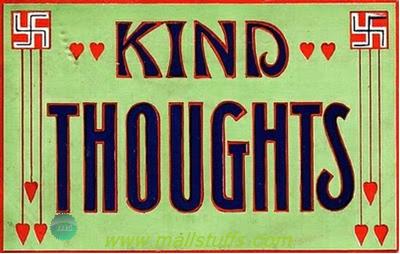
1910 American greeting card
The tradition of revering swastika as a good luck symbol was adopted by red Indians, today known as Native Americans. Native Americans used swastika faithfully in their arts, buildings, clothes, quilt, rugs, products, product or company name etc. They used swastika to represent sun, power, life, strength, good fortune and symbol of luck and prosperity.
Christian priests and missionaries today consider swastika as an evil and wicked symbol but you may be surprised to know that a century ago, almost all Christian priests and saints used swastika as the good luck symbol. For Ex: below is the Christmas postcard dated Dec 22, 1909 with postmark of Minneapolis city. In this card, swastika is used as a symbol of good fortune and prosperity. Titled at an angle of 45, this bright and golden embossed clockwise swastika certainly augments the richness and attraction of this greeting card

After world war association of swastika with Hitler, US government pressurize “Navajos”, short form for Native Americans, to abandon their cultural good luck symbol swastika. Under extreme pressure, several Native American tribes (the Apache, Navajo, Tohono O'odham, and Hopi) and other non-indian tribes who used swastika as the cultural symbol signed a decree stating that they would no longer use the swastika as their cultural symbol. They stated that they did so since the tourists were reluctant to buy their product as they regarded swastika as the evil symbol.
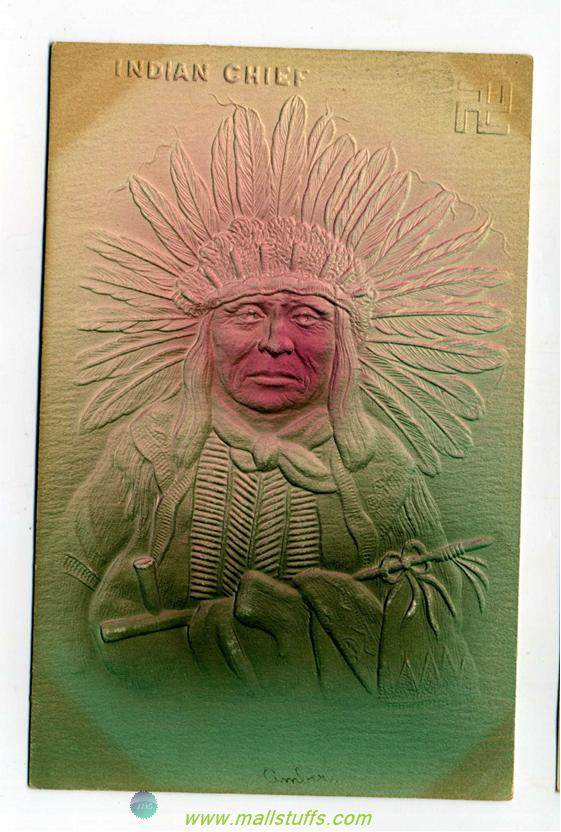
They stated the following about swastika in the signed decree:
“Because the above ornament which has been a symbol of friendship among our forefathers for many centuries has been desecrated recently by another nation of peoples.
Therefore it is resolved that henceforth from this date on and forever more our tribes renounce the use of the emblem commonly known today as the swastika or fylfot on our blankets, baskets, art objects, sandpainting, and clothing.”
This act indeed depicted the patriotism and love for their country but at the same time, it also depicted how easily the Native Americans abandoned cultural symbol of their ancestors and forefathers compared to Canadians, who resisted the change of their town name ‘Swastika’. Even today, this little flourished town is known as swastika. Check below article for reference
Swastika in Canadian buildings and culture
Originally, swastika was not shown in tilted form, but in the later ages specially in the early 1900’s, tilted swastika was used to enhance its decorative features like the one shown below where you can see an embossed and airbrushed American postcard of the 1905-1910 era, bearing the legend "To Darling Baby," along with a lavender swastika and ornamental bunch of Lily flowers.

I found titled swastika in many greetings card which kinda give me a feeling that they used it more like a decorative symbol than a good luck symbol. I guess tilted swastika was liked not only by Native American but also by Hitler, who used tilted swastika as its party logo. Below is one of such birthday greeting cards of the early 19th century long before the Hitler party came into existence.
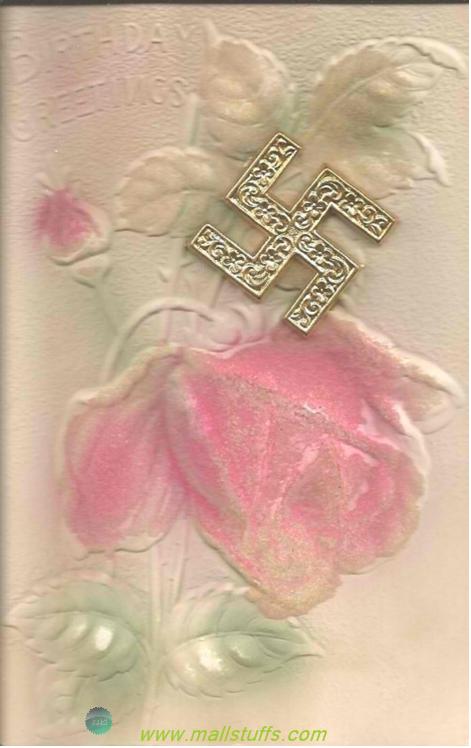
You can see a tilted swastika on top of a beautiful rose meant to dedicate love and good luck to the receiver of this card
In American culture, all swastikas were considered positive and its direction and tilt was usually based on how it looked and how it fit the artwork, label, card, etc. It had nothing to do with right is bad, left is good. Doesn’t tilted swastika look nice? If no is your answer than look at this one. This is the seasonal greetings card casually sent to close relatives and friends, especially to the ones who stayed in villages or remote areas.
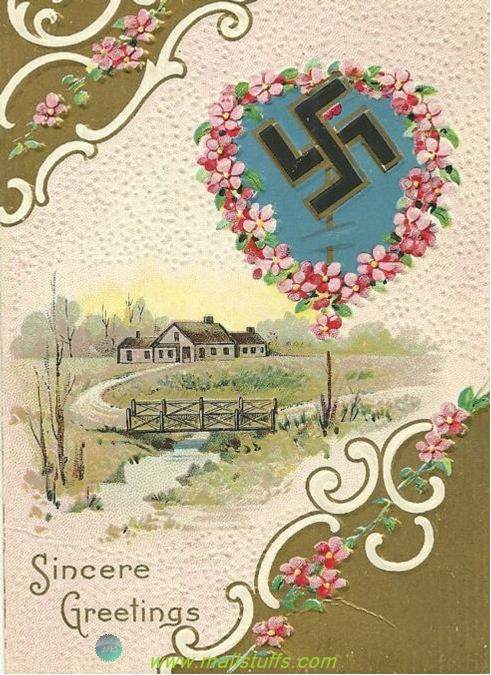
This is the 1910 greeting card which shows a county house surrounded by fields, stream of flowing water, a pool to pass by and a big swastika surrounded by pinky flowers to represent love, good luck and prosperity
If you still didn’t like this tilted swastika than there is an another one for you. You will appreciate this one especially if you have a special close friend. This is a very colorful card where each word is shown in different embossed colors with word ‘Friend’ written on top of a grass surrounded by hibiscus flowers. On the bottom of left side hibiscus flower is the clockwise swastika, the symbol of good luck and prosperity
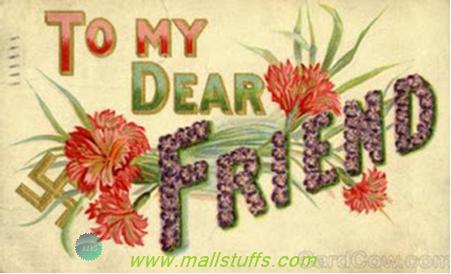
Courtesy: Cardcow.com
Friend word makes the above greeting card very precise which cannot be sent to everyone especially for companies who sends bulk of greeting cards. Such companies used a very generic greeting card like the one shown below which can be sent to everyone. This is the greeting card from the early 19th century where you see a hanging swastika with word ‘Dearest’ at the absolute middle.
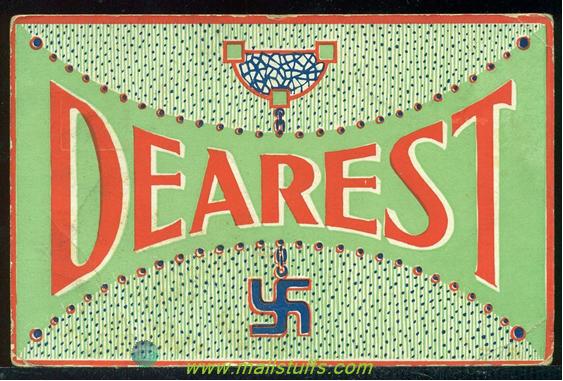
Either clockwise or anticlockwise swastika was used as a good luck symbol in almost all antique greeting cards. Below is the greeting card published by Western Publishing & Novelty Company, Los Angeles. On the bottom, you can see a man dressed in Native American costume followed by a series of clockwise swastikas. Just above the Native American picture, you can see anticlockwise swastika.
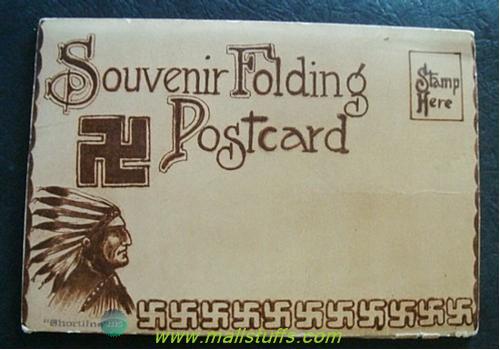
1920’s Souvenir Postcard of Santa Barbara, CA.
If you don’t know the difference between clockwise and anti-clockwise swastikas then please read the below article
Meaning and significance of Swastika-Hinduism sacred symbol
Using anticlockwise swastika is not considered an auspicious one in Hinduism since it represents dissolution of the universe. However, in Native American culture, it was widely used in greeting cards, may be because they were not aware of its meaning. Below is the 1920 greeting card published by Philadelphia Card Company, mailed in Hanover?
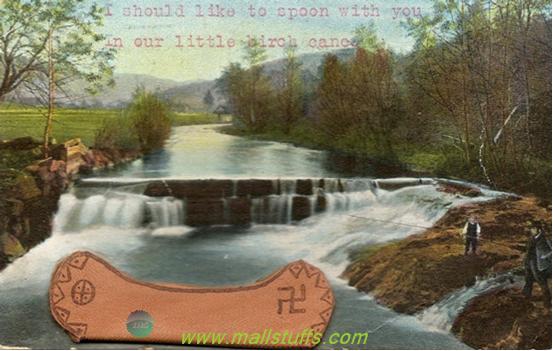
This card shows the Native American fishing in their local county stream surrounded by lush green fields and long trees
In below greeting card, anticlockwise swastika is used to address love and affection
 s
s
What you like the most? Nature, flowers, scenery, greenery etc.This was the reason why swastika was accompanied by flowers and natural scenes to make the greeting card more attractive and convincing to the buyer.
Below is the greeting card with lots of beautiful flowers in shapes of circles & love and swastika on either side of the card.

Greeting card sent with sincere regards and affection
Below is another greeting postcard with beautiful flowers and green leaves with message of remembrance and good luck. This is the 1920 birthday greeting card with golden clockwise swastika on all corners of the card.
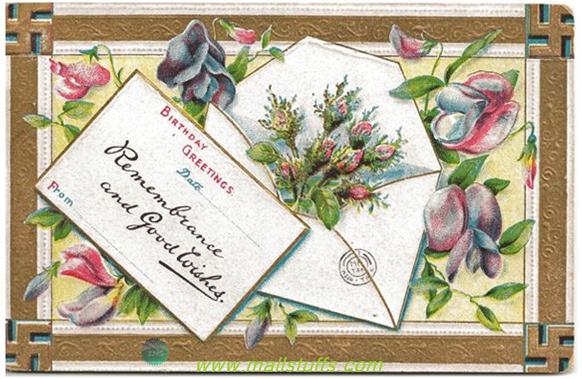
Birth day is the most special day in everyone life. Everyone looks forward to birthdays, be it your own or the birthday of your closed loved one's. No Birthdays is complete without cutting cake and wishes from friends, family, and sweetheart. Most of the time, distant relatives and closed ones stays very far away from you and hence, you can’t express their feelings face to face. So, we generally send birthday greeting cards to do the same. Below is one of such birthday greeting card with swastika symbol to express good luck wishes to the birthday guy
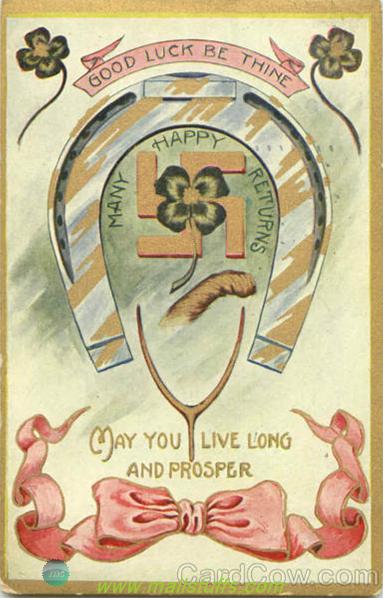
1909 birthday greeting card, Pennsylvania
Below is one more greeting card with sacred clockwise swastika symbol. Though it does not look that attractive, big lavender swastika in the middle does add some level of charmness.
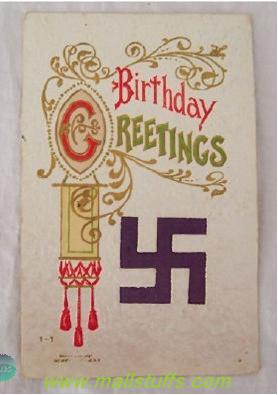
1908 Birthday Greeting card
Second most special day after birthday is New Year day. Everyone enjoys this day to the fullest and those who cannot enjoy with their closed ones send greeting cards wishes to them. Below is one of such greeting card published by International Art Publishing Company having swastika symbol to address good luck and prosperity. Even it has the message “Good luck attend you” this year.

New Year Postcard dated 28 December 1911, New York. Image courtesy: cardcow.com
Conclusion:
This article is intended to reclaim the lost significance and importance of humanity earliest symbol �Swastika�. Swastika is derived from the Sanskrit word �svastika�- "su" meaning "good," "asti" meaning "to be," and "ka" as a suffix. Swastika signifies the symbol of good luck, prosperity, peace and fortune. After its association with German Nazi party, this ancient symbol has faced a sad transition from a good luck symbol to symbol of evil and adversity. Swastika is still widely used as a good luck symbol in Asian countries like India, China, Japan, Korea, Thailand, Vietnam, Indonesia etc.This symbol has a great spiritual meaning and significance in Hinduism and its derived religions like Buddhism and Jainism.
Note: Images used on this website
are either a production of Bhaktivedanta Book Trust(https://www.krishna.com), Iskcon
Foundation or were found in google search under "Free to use and share". If any
of the images presented here violates copyright issues or infringes anyone copyright
or are not under "Fair use", then please bring it to our notice. Read
Disclaimer for more.
Share this to your friends. One of your friend is
waiting for your share.
Related Articles
Swastika in american antique greeting cards
Swastika in american consumer products and pharmaceutical industry
Swastika signs on american advertisements and banners
Why and how raksha bandhan is celebrated
Post Comment